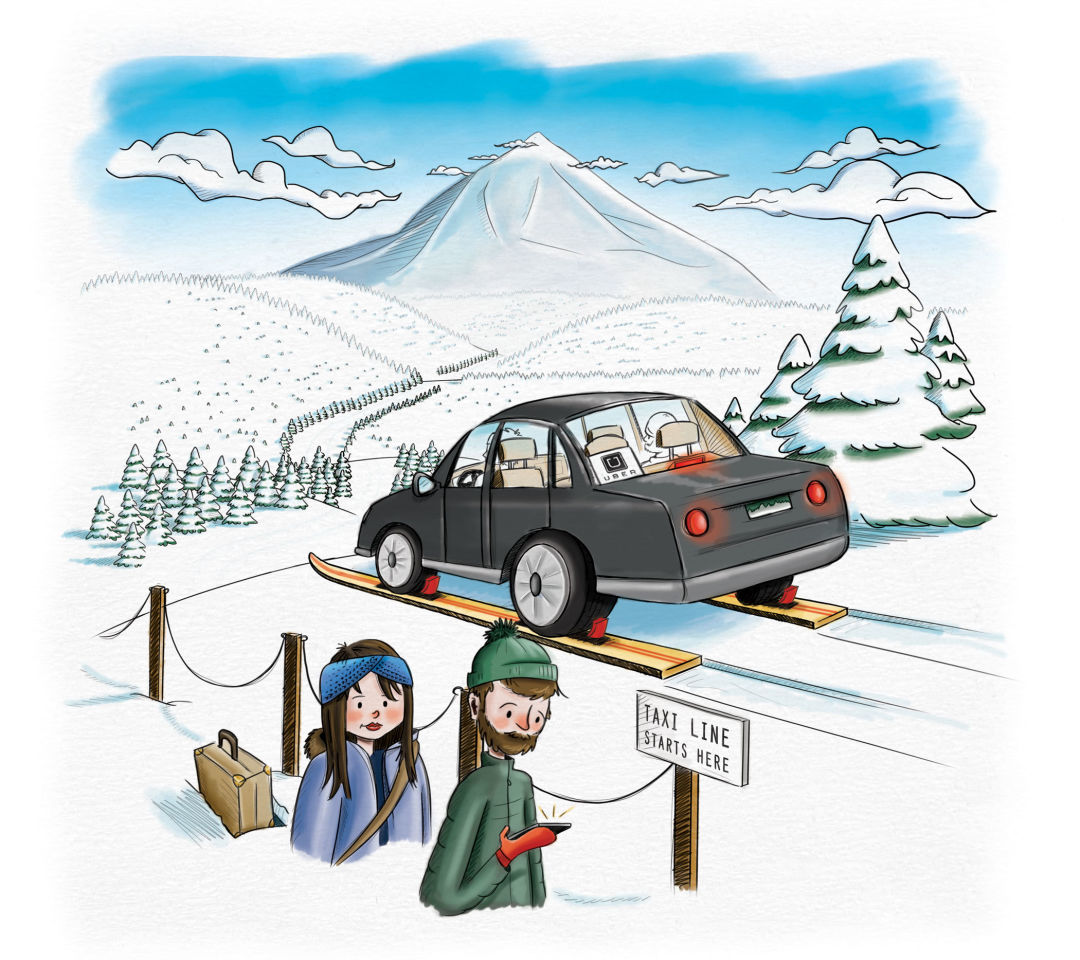Happily Uber After?

Image: Brittney Knight
Overheard on the chairlift at Ajax: Two young ski bums bemoaning the low pay and demanding hours of their seasonal jobs. But when the conversation turns to driving for Uber, the popular app-based, on-demand car service, the pair responds in awe at what seems a dream job, with a self-determined schedule, flexible hours, and plenty of time left over to hit the slopes.
That’s exactly the kind of enthusiasm that Uber, which celebrated its one-billionth ride on Christmas Eve 2015, is hoping to generate as it continues its push into mountain resorts, including Tahoe, Utah ski areas, and Aspen. The service launched locally in 2013 but struggled to gain momentum when the few drivers who signed up didn’t get many passengers, and the few passengers who logged in often couldn’t find drivers. The company now hopes to solve this chicken-and-egg conundrum with a critical mass of drivers up front to make the service more viable.
The customers are already there, asserts Uber spokeswoman Jaime Moore. The savvy tech company has an algorithm that indicates how many people open its app in areas where Uber is not yet operational “and that’s how we see where to go next,” she says. Demand is apparently strong in Colorado’s mountain resorts, especially during peak tourist season, on weekend nights, and for special events like the X Games.
The strategy seems to be working regionally. As of mid-January, Uber’s recruiting efforts had resulted in about 100 drivers in the central Colorado mountains, from Breckenridge to Aspen. That’s up from just 18 drivers before the push began last fall. Correspondingly, rides went up 600 percent across the region in the last three months of 2015, says Moore. (Like everything else, Uber is pricier in Aspen, with an $11.95 base fare compared to $4.95 in Denver.)
With just “a handful” of drivers, according to Moore, Uber is not ubiquitous in Aspen just yet, and opinions are mixed as to how it’s going so far.
Longtime local Deborah Coombe has kept busy enough as a part-time driver since the fall. “Every time I want to Uber drive, I [do],” says Coombe, who also holds a full-time job. Rides are generally short, and demand is limited outside of peak periods, so “it’s supplementary income,” she notes.
Another Uber driver, Ziska Childs, says the company has not yet grasped the rarefied Aspen market. Seasonally affected demand, a fare structure that doesn’t reflect local geography, and technical issues with the drivers’ app are not helping the company attract and retain the number of drivers it needs to be viable, Childs maintains. “They should be looking at this as a valley-wide market,” she says, pointing to hotel guests in Basalt and Glenwood as potential users who are currently underserved. Add to that tourists hauling ski gear, locals with dogs (who aren’t welcome on buses), and visitors from cities where Uber is an integral part of transportation options, and “the potential is enormous,” she adds, “but it’s being squandered by Uber, in my opinion.”
In general, Aspen has caught the sharing-economy bug big-time, with more than 300 local listings on Airbnb and North America’s first mountain-town bike-share program, WE-cycle, which wrapped its third season last fall. “Shared mobility is [becoming] on demand, so people can get rides when they want,” says Mirte Mallory, co-founder of WE-cycle, which introduced Transit App, a real-time tracker of public transport options (including Uber), locally last fall.
If Uber can achieve its goal of signing up more Aspen drivers, and make some apparently needed tweaks to its local business plan, it could come closer to reaching the saturation levels that high-country riders apparently demand. And then those ski bums on the lift could even be on their own road to higher job satisfaction.













































